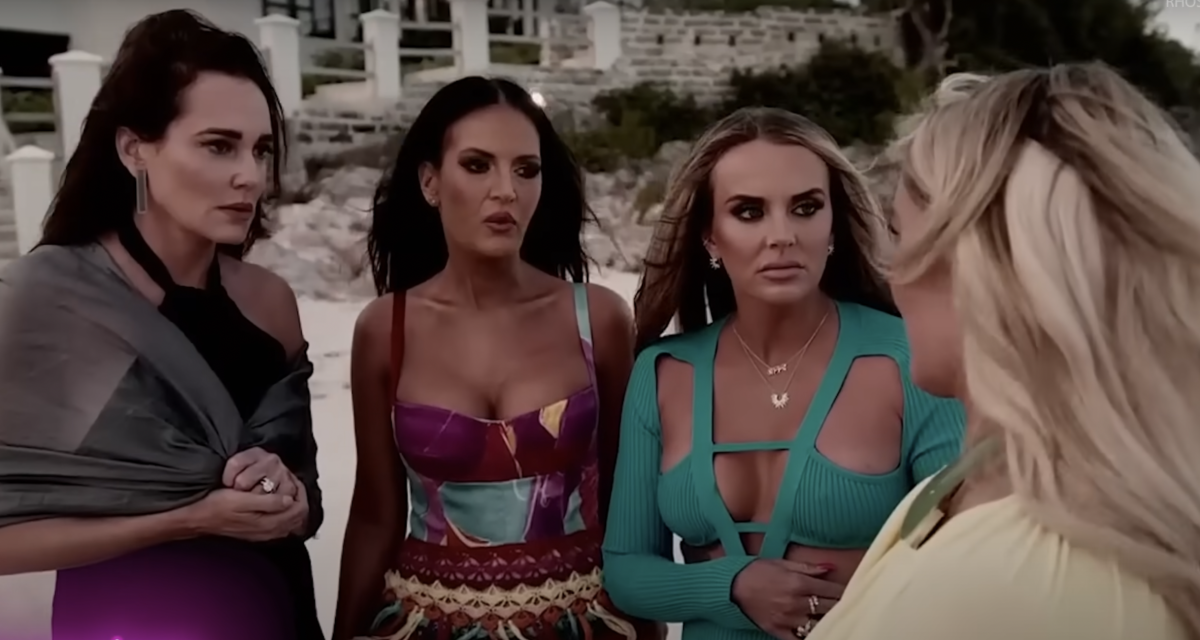How Monica Garcia made ‘The Real Housewives of Salt Lake City’ unhinged, unmissable TV
Los Angeles Times illustration; photo by Bravo
It’s rare that a single episode of television invites comparisons to “Big Little Lies,” “The Usual Suspects,” the novels of Agatha Christie and the timeline-scrambling films of Christopher Nolan.
It’s rarer still when the show in question is the 10th domestic version of a long-running reality TV franchise whose best known star is currently serving a 6½-year prison sentence for wire fraud.
But that’s exactly what happened when the Season 4 finale of “The Real Housewives of Salt Lake City” ran on Bravo this month. In a jaw-dropping twist that had been teased for months, brash, extremely quotable cast newbie Monica Garcia was outed as one of the masterminds behind Reality Von Tease, an Instagram account that trafficked in gossip about Jen Shah, a breakout star of the show and Garcia’s former boss — who is now incarcerated in Texas — and occasionally poked fun at the other “Salt Lake” ladies.
Set on the windswept beaches of Bermuda, where the cast had ostensibly gone to celebrate Garcia’s birthday, “Mysteries, Revealed?” was quickly hailed as one of the all-time great episodes in the “Real Housewives” pantheon — and possibly in all of reality TV. It triggered a flurry of memes and frenzied analysis on social media, capping off a season that offered more campy theatrics than a high school production of “A Streetcar Named Desire.” (e.g. when cast member Angie Katsanevas told her nemesis Meredith Marks, “You look like a trampoline with eyes,” an evocative reference to her unnaturally taut skin.
“The Real Housewives of Salt Lake City” adds a novel ingredient — Mormonism — to the usual pettiness, plastic surgery and conspicuous consumption.
Suddenly, thanks to Reality Von Tease, “Salt Lake City” was the only thing the Bravo fandom wanted to talk about. But just as “Scandoval” turned “Vanderpump Rules” into an inescapable pop culture phenomenon last year, “Mysteries, Revealed?” was so undeniably compelling: It became the most-watched episode of the show since the Season 1 premiere and commanded attention well outside the usual “Housewives” audience.
U.S. Rep. Robert Garcia (D-Long Beach) quoted the finale during a House Oversight Committee hearing. It was even the talk of the red carpet at the recent Golden Globe Awards, where noted Bravoholic Jennifer Lawrence described the finale as “the best reality TV finale, I think, ever,” and said the women of “Salt Lake” had delivered performances worthy of an Oscar.
“I’ll give them mine. I don’t care,” quipped the actor. “They deserve it.”
No one in the cast did more scenery-chewing than Heather Gay, who has played the role of the Relatable One since “Salt Lake” debuted in 2020 and is the author of a bestselling memoir called “Bad Mormon,” about her journey away from the Church of Jesus Christ of Latter-day Saints.

Gay confronted Garcia about her virtual alter ego during a beachfront dinner with the entire cast on the final night of their trip to Bermuda. With assistance from the sly editors at Bravo, who made copious use of flashbacks and time-jumps, Gay laid out the damning evidence against Garcia in a fiery monologue that would have been right at home in the final act of a David E. Kelley legal drama.
She painted Garcia as a sociopathic impostor and overzealous fan who, like a basic cable Eve Harrington, ingratiated herself with her co-stars while trying to trash them online. She delivered each line, each gesture, with the precision of a classically trained actor reciting a Shakespearean soliloquy, building to a final send-off in which she told Garcia: “Pack your bags and go.” To explain why she was so troubled by Garcia’s apparent deception, Gay even dropped one final bombshell, alleging that last season’s mysterious black eye was caused by Shah, as many viewers long suspected. Gay had been traumatized by a manipulative co-star and didn’t want to live through that again.
The performance turned the phrase “Receipts. Proof. Timeline. Screenshots.” into a meme overnight (seriously, Google her name) and helped Gay, a fan favorite whose status had fallen because of her baffling loyalty to Shah, reaffirm her status as one of the brightest stars in the “Housewives” firmament.
Yet every great hero needs an equally accomplished villain. And all the rightful praise for Gay — and the wildly entertaining episode she anchored so deftly — ignored an obvious, if inconvenient, fact: Garcia had been accused of nothing illegal, or even particularly egregious by the (admittedly low) standards of reality TV. Unlike Shah, she hadn’t perpetrated a decade-long scheme that defrauded vulnerable elderly people out of their savings. What she had done — using a finsta to sling mud at her cast mates — is barely a misdemeanor according to the “Real Housewives” penal code.
But more egregiously, to her co-stars at least, Garcia, the show’s first Latina, was guilty of a different kind of crime: wanting reality fame too badly — and being too skilled at playing the game. While it’s become customary for social media commentary and fan chatter to influence the storylines on “The Real Housewives,” Garcia was a fan who managed to infiltrate the show and become an actual character in it, like an understudy who stepped into the leading role on her first night.

In Part 1 of the Season 4 reunion, filmed months after the fateful trip to Bermuda on an elaborate set resembling a pirate ship, Gay played a voicemail message in which Garcia said she worked as Shah’s assistant because “Kim Kardashian was a f—ing assistant and look at that b— right now.” Gay evidently viewed the message as a smoking gun, exculpatory evidence that proved Garcia was a wannabe who worked for Shah, apparently without pay, because she wanted to be on reality TV. (With her dark hair, inflated lips and heavy bronzer, Garcia, like countless other aspiring influencers of her generation, even has the physical appearance of an artificial intelligence-generated Kardashian.) Garcia’s response to these allegations was nonchalant. “Why wouldn’t I try to get on the show?” she said with a shrug. “I applied like everybody else.” Her point was simple: They are all on TV because they want to be on TV. Why deny the obvious?
Among “Housewives” fandom, debate has raged about whether Garcia should return for Season 5, but on Tuesday, the show’s producers told Variety that she wouldn’t back. Bravo has not yet made any announcements, and in an interview with the Hollywood Reporter, the show’s producers made it clear that there is a lively ongoing discussion about how to proceed.
They would have been wise to bring Garcia back. While some housewives spend years dodging painful conversations about their marriages or finances until their evasions finally catch up with them, Garcia was open and vulnerable right out of the gate — or was at least savvy enough to know it would benefit her to appear that way. During one of her first hangouts with Gay, she revealed she had been ex-communicated from the LDS Church “for f—ing my brother-in-law for 18 months.” She talked about being abandoned by her father, argued viciously with her mom on camera, and refused to be intimidated by her more seasoned co-stars: On a cast trip to Palm Springs, she even dared to call out Lisa Barlow — the show’s Diet Coke-addled diva — for melting down over a $60,000 ring she lost in the bathroom.
If she also made claims that seemed dubious — like when she said that a friend in the Secret Service had tipped her about the investigation into Shah — it didn’t matter, because she was good TV. Right out of the gate, the divorced mother of four understood that what makes “Salt Lake” unique is how extra, how thoroughly unhinged the show can be — and she’s leaned into the drama at every possible turn.
Since its debut in late 2020 — a time when audiences were desperate for some absurd diversions — “Salt Lake” has always had a down-market feel compared to other cities in the franchise, like “New York” or “Beverly Hills.” The outfits are cheesier, the cosmetic enhancements less refined, and the McMansions somehow more generic. The cast members aren’t real estate tycoons or fashion designers; they run medi-spas or have husbands who work for multilevel marketing companies.
What they do offer is a brazen willingness to go for broke in front of the cameras. If, as Susan Sontag once wrote, “Camp is a woman walking around in a dress made of three million feathers,” “The Real Housewives of Salt Lake City” is a show about an entire group of women who wear nothing but garish feathered dresses. And hats. And blazers. The fights have always been more ridiculous (see: the premiere episode, in which Mary Cosby told Shah, “You smell like hospital”), the meltdowns more quotable (see: the hot mic tirade in which Barlow called her one-time bestie Marks a “piece of s— garbage whore”), the pot-stirring more obvious. This self-conscious performative quality (plus the cheeky editing) is what makes “Salt Lake City” such a delightfully kitschy spectacle.
What also helped “Salt Lake” stand out was its cultural and geographic setting in Utah, the home of the LDS Church. It may lack the aspirational glamour or cultural vibrancy of other locations, but the setting adds a fascinating spiritual dimension to a show that has always been a fascinating look at gender, class and race.
Most of the women in the original cast were current or former members of the LDS church; another, the perpetually cranky Cosby, who left the show after Season 2, only to rejoin as a “friend of” in Season 4, is the first lady of a Pentecostal Church and is married to her step-grandfather. Just as crucial, Utah is also a hotbed for momfluencers, many of them Mormon, who project an idealized version of domesticity on social media. Many of the cast members, including both Garcia and Gay, have spoken about the pressure faced by women in LDS culture.
.
The future of the show was thrown into doubt last year when Shah, the cast’s most reliable font of drama even before her indictment, pleaded guilty to federal wire fraud charges. Now at a federal facility in Texas, she continues to generate storylines far away from the Bravo cameras (she has reportedly found new purpose as a fitness instructor and is helping fellow inmate Elizabeth Holmes strengthen her core.)
By embracing the villain mantle, Garcia filled the void — and launched “The Real Housewives of Salt Lake City” into the stratosphere.
More to Read
It's a date
Get our L.A. Goes Out newsletter, with the week's best events, to help you explore and experience our city.
You may occasionally receive promotional content from the Los Angeles Times.








